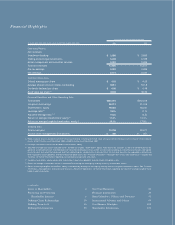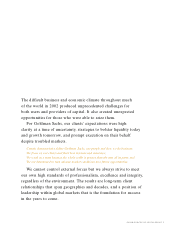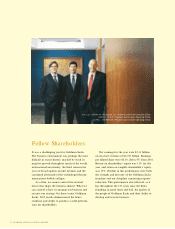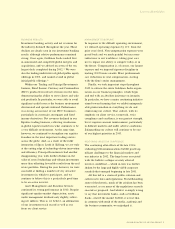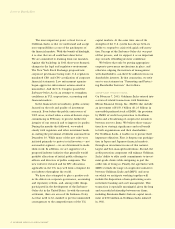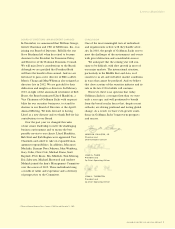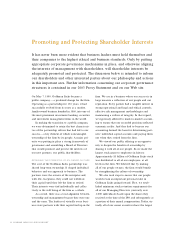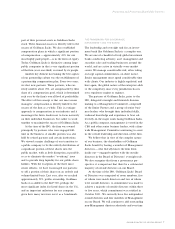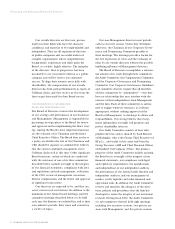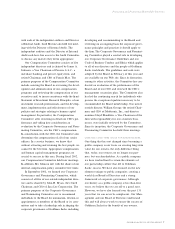Goldman Sachs 2002 Annual Report Download - page 6
Download and view the complete annual report
Please find page 6 of the 2002 Goldman Sachs annual report below. You can navigate through the pages in the report by either clicking on the pages listed below, or by using the keyword search tool below to find specific information within the annual report.
The more important point, at least for us at
Goldman Sachs, is that we understand and accept
our responsibilities as one of the gatekeepers of
the financial markets. With the benefit of hindsight,
it is clear that we all could have done better.
We are committed to learning from our mistakes.
Against this backdrop, in 2002 there were dramatic
changes in the legal and regulatory environment.
The New York Stock Exchange proposed new
corporate governance listing rules. U.S. regulators
mandated CEO and CFO certification of corporate
financial statements. Law enforcement agencies
began aggressive enforcement actions aimed at
misconduct. And the U.S. Congress passed the
Sarbanes-Oxley Act in an attempt to strengthen
confidence in U.S. corporations, accounting and
financial markets.
In the financial services industry, public scrutiny
focused on the role and quality of investment
research. Even before the public controversy of
2002 arose, we had taken a series of decisive steps,
commencing in February, to protect further the
integrity of our research and to improve its quality.
During the months that followed, we worked
closely with regulators and other investment banks
in crafting the provisional settlement announced on
December 20. While many of the new rules were
initiated primarily to protect retail investors—not
our market segment —we are determined to make
them work. In addition, we are supportive of a
proposed industry initiative that generally would
prohibit allocations of initial public offerings to
officers and directors of public companies. The
new rules for research and for IPO allocations
applicable in the U.S. may well form a template for
our industry throughout the world.
We have also attempted to play a positive role
in the debate on corporate governance, accounting
and regulatory reform, and, among other things,
participated in the development of the Sarbanes-
Oxley Act in the United States. As with the research
settlement, there are areas of the Sarbanes-Oxley
Act that need to be clarified to prevent unintended
consequences to the competitiveness of the U.S.
capital markets. At the same time, one of the
strengths of the U.S. system has always been its
ability to respond to crisis with quick self-correc-
tion. Passage of the Sarbanes-Oxley Act was part
of that process, and we support it as an important
step towards rebuilding investor confidence.
We believe that only by putting appropriate
corporate governance mechanisms in place, and
otherwise aligning the interests of management
with shareholders, can there be sufficient focus on
shareholder interests. In that connection, we refer
you to our statement on “Promoting and Protect-
ing Shareholder Interests” that follows.
SIGNIFICANT TRANSACTIONS
On February 7, 2003, Goldman Sachs entered into
a series of related transactions with Sumitomo
Mitsui Financial Group, Inc. (SMFG) that include
an investment of ¥150.3 billion ($1.25 billion)in
convertible preferred stock of SMFG, the provision
by SMFG of credit loss protection to Goldman
Sachs and a broadening of cooperative initiatives
between our two firms. We believe these transac-
tions have strategic significance and real benefit
to both organizations and their shareholders.
For Goldman Sachs, it enables us to pursue three
important objectives. First, it deepens our participa-
tion in Japan and Japanese financial markets,
through an investment in one of that nation’s
largest and best-managed institutions. Second, the
credit protection component will enhance Goldman
Sachs’ ability to offer credit commitments to invest-
ment-grade clients while mitigating in part the
credit risk of doing so. Finally, the agreement with
SMFG extends the range of cooperative initiatives
between Goldman Sachs and SMFG, and areas
on which we anticipate working together will
include the disposition of non-performing assets,
investment banking and asset management. This
transaction is especially meaningful, given the long
and successful relationship between our firms,
including Sumitomo Bank’s historic capital invest-
ment of $500 million in Goldman Sachs initiated
in 1986.
4GO LDMAN SA CH S 2002 A N N UA L R EPO RT
Letter to Shareholders


